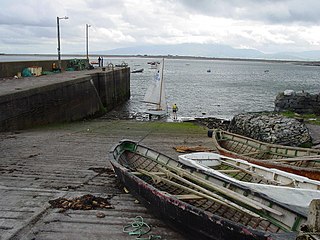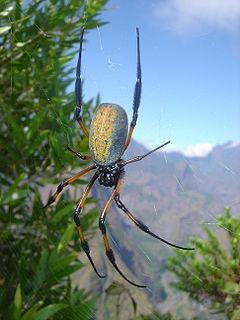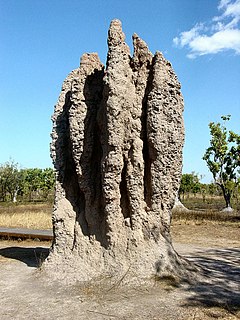
The Thomisidae are a family of spiders, including about 170 genera and over 2,100 species. The common name crab spider is often linked to species in this family, but is also applied loosely to many other families of spiders. Many members of this family are also known as flower spiders or flower crab spiders.

The yellow crazy ant(Anoplolepis gracilipes) is a species of ant, thought to have originated in West Africa, that has been accidentally introduced to numerous places in the world's tropics.

The chelicerae are the mouthparts of the Chelicerata, an arthropod group that includes arachnids, horseshoe crabs, and sea spiders. Commonly referred to as "jaws", chelicerae may be shaped as either articulated fangs, or similarly to pincers. Some chelicerae, such as those found on nearly all spiders, are hollow and contain venom glands, and are used to inject venom into prey or a perceived threat. In Pisaurina mira, also known as the nursery web spider, the chelicerae are utilized to snatch the prey once it becomes within reach, facilitating the "sit-and-wait ambush predator" behavior. Both pseudoscorpions and harvestmen have structures on their chelicerae that are used for grooming.

Huntsman spiders, members of the family Sparassidae, are known by this name because of their speed and mode of hunting. They are also called giant crab spiders because of their size and appearance. Larger species sometimes are referred to as wood spiders, because of their preference for woody places. In southern Africa the genus Palystes are known as rain spiders or lizard-eating spiders. Commonly, they are confused with baboon spiders from the Mygalomorphae infraorder, which are not closely related.

Corinnidae is a family of araneomorph spiders, sometimes called corinnid sac spiders. The family, like other "clubionoid" families, has a confusing taxonomic history. Once it was a part of the large catch-all taxon Clubionidae, now very much smaller. The original members of the family are apparently similar only in that they have eight eyes arranged in two rows, conical anterior spinnerets that touch and are generally wandering predators that build silken retreats, or sacs, usually on plant terminals, between leaves, under bark or under rocks.

Scraggane is a fishing port located on the Maharees peninsula near Castlegregory in County Kerry, Ireland.

Whirlwind is a supervillain appearing in American comic books published by Marvel Comics. He is a recurrent villain of Ant-Man and the Wasp, but he also fought Captain America and Spider-Man among others.

Trichonephila inaurata, synonym Nephila inaurata, commonly known as the red-legged golden orb-weaver spider or red-legged nephila, is a species of orb-weaver spider of the genus Trichonephila. It is native to southern and East Africa, as well as several islands of the western Indian Ocean.

In ecology, crypsis is the ability of an animal or a plant to avoid observation or detection by other animals. It may be a predation strategy or an antipredator adaptation. Methods include camouflage, nocturnality, subterranean lifestyle and mimicry. Crypsis can involve visual, olfactory, or auditory concealment. When it is visual, the term cryptic coloration, effectively a synonym for animal camouflage, is sometimes used, but many different methods of camouflage are employed by animals or plants.

Nepenthesinfauna are the organisms that inhabit the pitchers of Nepenthes plants. These include fly and midge larvae, spiders, mites, ants, and even a species of crab, Geosesarma malayanum. The most common and conspicuous predators found in pitchers are mosquito larvae, which consume large numbers of other larvae during their development. Many of these animals are so specialised that they cannot survive anywhere else, and are referred to as nepenthebionts.

The great spider crab, Hyas araneus, is a species of crab found in northeast Atlantic waters and the North Sea, usually below the tidal zone.
The following outline is provided as an overview of and topical guide to zoology:
Wildlife of Sri Lanka includes its flora and fauna and their natural habitats. Sri Lanka has one of the highest rates of biological endemism in the world.
Many species of arthropods regularly or occasionally bite or sting human beings. Insect saliva contains anticoagulants and enzymes that cause local irritation and allergic reactions. Insect venoms can be delivered by their stingers, which often are modified ovipositors, or by their mouthparts. Insect, spider and scorpion venom can cause serious injury or death. Dipterans account for the majority of insect bites, while hymenopterans account for the majority of stings. Among arachnids spider bites and mite bites are the most common. Arthropods bite or sting humans for a number of reasons including feeding or defense. Arthropods are major vectors of human disease, with the pathogens typically transmitted by bites and rarely by stings or other contact. Another common negative effect is interference with military activity.

Spiders are air-breathing arthropods that have eight legs, chelicerae with fangs generally able to inject venom, and spinnerets that extrude silk. They are the largest order of arachnids and rank seventh in total species diversity among all orders of organisms. Spiders are found worldwide on every continent except for Antarctica, and have become established in nearly every land habitat. As of August 2021, 49,623 spider species in 129 families have been recorded by taxonomists. However, there has been dissension within the scientific community as to how all these families should be classified, as evidenced by the over 20 different classifications that have been proposed since 1900.

Structures built by animals, often called animal architecture, abound in nature. Examples of animal structures include termite mounds, wasp and beehives, burrow complexes of rodents, beaver dams, elaborate nests of birds, and webs of spiders.

Bucranium is a genus of spiders in the family Thomisidae.

Xysticus cristatus, the common crab spider, is a European spider from the family Thomisidae.















